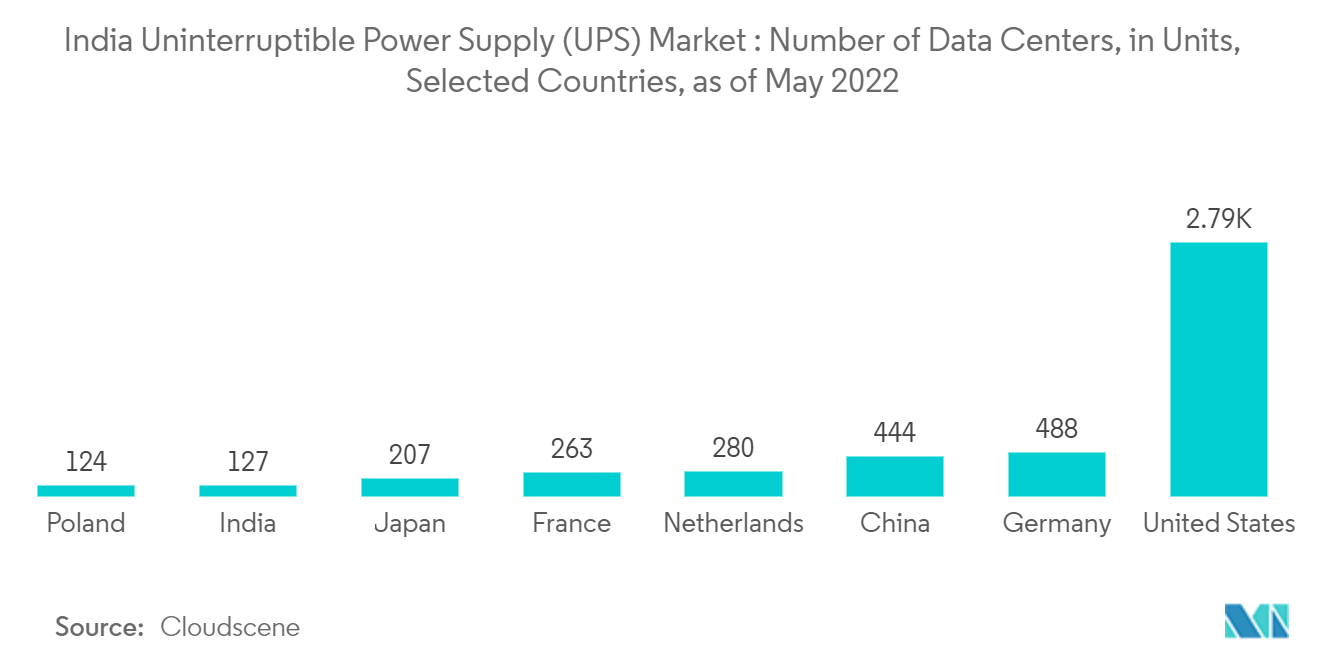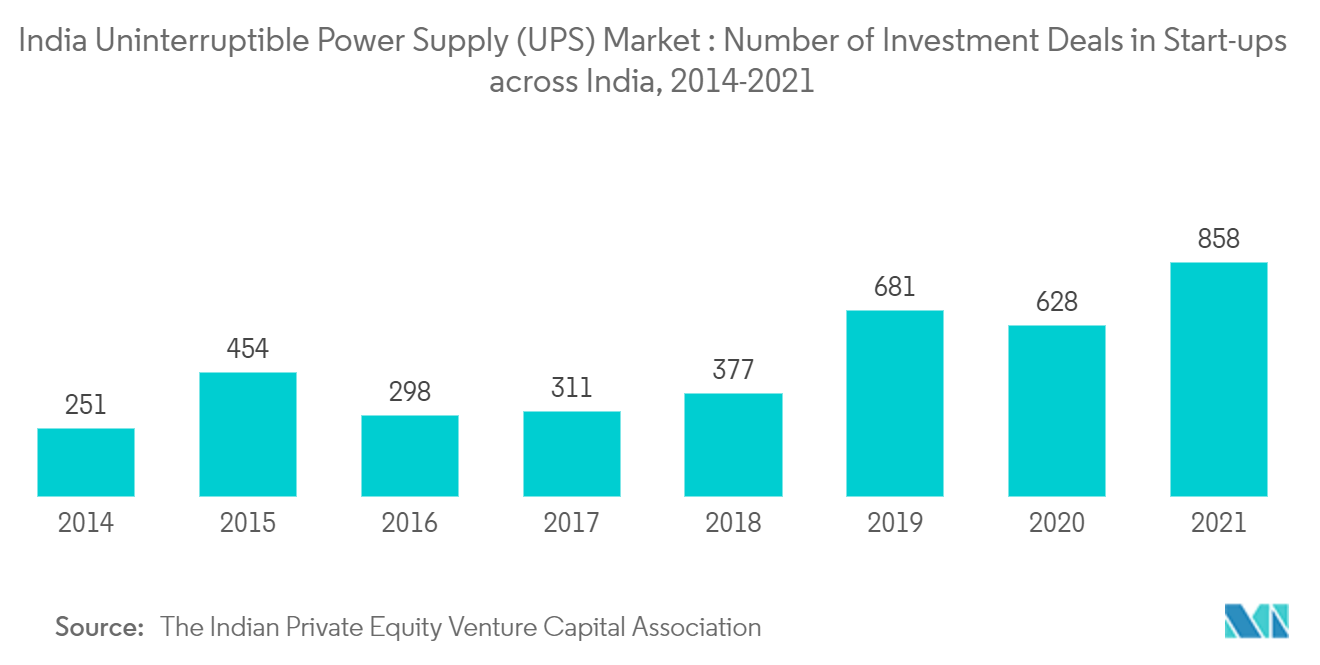Market Trends of India Uninterruptible Power Supply (UPS) Industry
This section covers the major market trends shaping the India UPS Market according to our research experts:
Data Centers Segment to Witness Significant Growth
- Data centers are facilities that store vast amounts of sensitive data. These facilities are needed to be operational throughout the clock, maintain data safety, and reduce downtime. They are equipped with an uninterrupted power supply. Furthermore, the data centers are connected to the internet, and with the help of an uninterruptible power supply, the data centers work smoothly without any interruption in internet connectivity. An uninterruptible power supply has redundant configurations and dual bus capabilities. Thus, it requires less uptime and can provide facility-wide protection for sensitive electronics. Moreover, an uninterruptible power supply provides power without blackouts, brownouts, sags, surges, and noise interference.
- India has witnessed steady growth in the number of data centers across the country in the last couple of years, ascribing to a significant rise in digitization in the last couple of years. As of May 2022, India has around 127 data centers.
- Furthermore, there is a rise in cloud-based networks. This can be ascribed to higher integration as corporations worldwide are shifting toward cloud-based networks rather than maintaining their infrastructure. Moreover, increased investment and application of artificial intelligence, the Internet of Things (IoT), and machine learning are transforming various sectors, such as industry 4.0, financial technology, global cities, digital infrastructure, and communications.
- Major companies are showing interest in developing data centers. For instance, in May 2022, Cisco launched its first data center in India. The company aims to cater to rising customer demands for cyber-defense and data localization. Thus, Cisco's Duo has established its first data center in India. Furthermore, with this investment, Cisco aims to build future-ready, data-compliant security infrastructure in India. Moreover, this data center would serve various industries, such as the public sector, healthcare, banking, financial services, and insurance. The new data center is part of Duo's global expansion strategy to spread its network across APAC, Europe, and the United States.
- In January 2022, the diversified Adani Group invested more than USD 55.72 million in two data center projects in Uttar Pradesh, India. According to the Uttar Pradesh government, the two data centers are expected to be built in Noida sectors 62 and 80, respectively. Furthermore, Adani Group has formed a subsidiary, Adani-EdgeConneX Indian Joint Venture, to create a data center in Mumbai, India. Moreover, the company aims to develop 1 GW of data center capacity in the next ten years. These projects are expected to be located in various cities in India, including Chennai, Navi Mumbai, Noida, Vizag, and Hyderabad.
- All these investments in data center development would lead to higher demand for the uninterruptible power supply, driving India's uninterruptible power supply market during the forecast period.

High Capital Cost and Operational Expenditure of UPS Restraining Market Growth
- Despite being a reliable and highly responsive system guaranteeing an immediate power supply in the event of a power failure, the major concern about the uninterruptible power supply (UPS) system is its cost. UPS requires a significant startup investment. For instance, in 2021, the number of private equity and venture capital deals in startups in India increased from 628 in the previous year to 858. Even a single unit for home use can cost hundreds of dollars. On the other hand, corporate setups on a large-scale run into tens of thousands of dollars for the machinery alone. These major installations also require an infrastructure setup that can significantly increase the total setup cost. Therefore, not all users could afford them, hampering the market's growth.
- Uninterruptible power supplies, such as the Online Double Conversion systems, have a complicated design, generating higher heat and lower overall efficiency, increasing operating costs. Moreover, UPS batteries do not last forever. Like all rechargeable batteries, the capacity of a UPS to hold charge diminishes over time. Depending on the model, a UPS battery lasts around five to ten years. After this, the old battery requires proper disposal, and a new battery must be purchased. Though many UPS manufacturers and retail stores recycle the UPS batteries used at homes for free, corporations must pay for the safe disposal of their equipment.
- Additionally, using a UPS system involves several considerations owing to the maintenance of the system. The maintenance cost is much higher, especially for corporate offices and industries, as it involves many UPS connections and requires a skilled electrician to be appointed to manage wiring systems and ensure error-free services. Moreover, for the proper functioning of the UPS system, it must be with sufficient ventilation since it regularly emits fumes. These factors are expected to increase the cost of a UPS and, in turn, restrain the growth of the market over the forecast period.
- The UPS system draws more power than a standalone device in terms of power consumption. The amount required is significantly higher than the actual amount needed by the devices, as UPS needs to keep its batteries always charged. This situation leads to an unavoidable waste of power, correlated to the amount of electricity used in the system. In large-scale applications, this additional power consumption represents a high additional cost. This wasted energy should also be considered while considering the environmental practices of businesses.
- Therefore, the system's high capital cost and operational expenditure are expected to limit the growth of the market studied during the forecast period.


